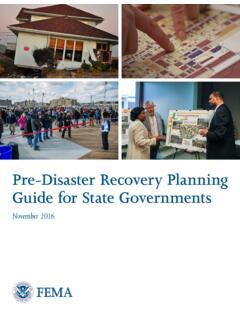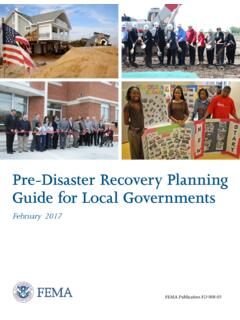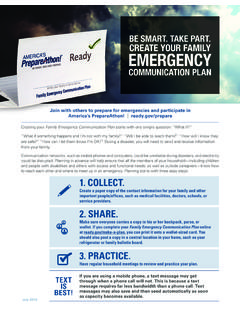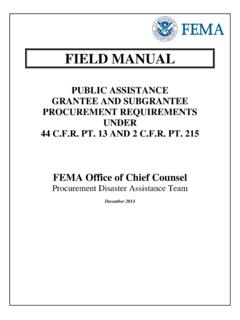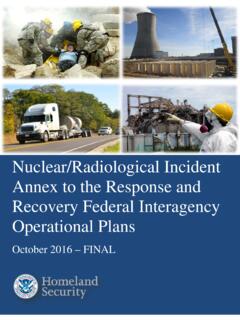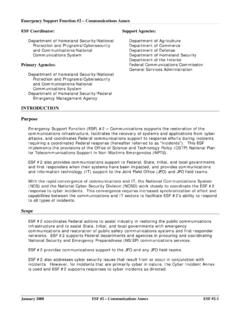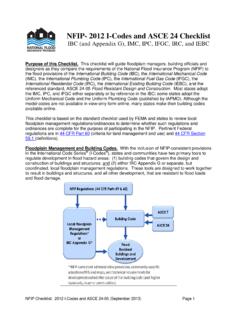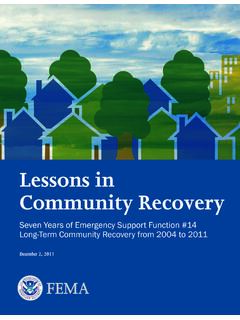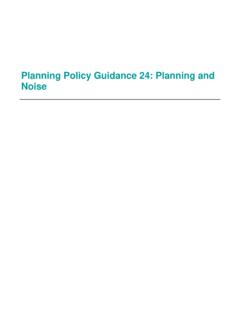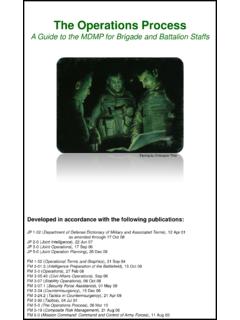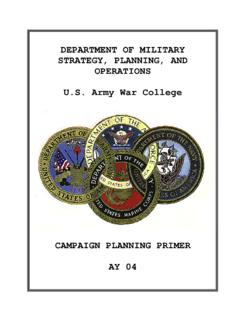Transcription of Homeland Security Exercise and Evaluation …
1 PRE-DECISIONAL DRAFT Intro-1 Homeland Security Exercise and Evaluation Program (HSEEP) April 2013 Homeland Security Exercise and Evaluation Program i Contents INTRODUCTION AND OVERVIEW .. INTRO-1 Purpose .. Intro-1 Role of Exercises .. Intro-1 Applicability and Scope .. Intro-2 Supersession .. Intro-2 How to Use This Document .. Intro-2 Revision Process .. Intro-3 1. HSEEP FUNDAMENTALS .. 1- 1 Overview .. 1- 1 Fundamental Principles .. 1- 1 Exercise Program Management .. 1- 1 Exercise Methodology .. 1- 2 Exercise Design and Development .. 1- 3 Exercise Conduct .. 1- 3 Exercise Evaluation .. 1- 3 Improvement planning .. 1- 3 2. Exercise PROGRAM MANAGEMENT .. 2- 1 Overview .. 2- 1 Engage Elected and Appointed 2- 1 Multi-year Exercise Program Priorities .. 2- 1 Training and Exercise planning Workshop .. 2- 2 Multi-year Training and Exercise Plan .. 2- 3 Progressive Approach .. 2- 3 Discussion-Based Exercises.
2 2- 4 Operations-Based Exercises .. 2- 5 Rolling Summary of Outcomes .. 2- 6 Manage Exercise Program Resources .. 2- 7 Exercise Budget Management .. 2- 7 Program Staffing .. 2- 7 Other Resources .. 2- 7 3. Exercise DESIGN AND DEVELOPMENT .. 3- 1 Overview .. 3- 1 Exercise Foundation .. 3- 1 Exercise planning Team and Events .. 3- 2 Exercise planning Team 3- 2 Exercise planning Team Positions .. 3- 3 planning Activities .. 3- 4 Exercise Design .. 3- 9 Scope .. 3- 10 Exercise Objectives .. 3- 11 Evaluation Requirements .. 3- 12 Scenario .. 3- 12 Exercise Documentation .. 3- 13 Media or Public Affairs Guidance .. 3- 19 Exercise Development .. 3- 20 planning for Exercise Logistics .. 3- 20 planning for Exercise Control .. 3- 22 Homeland Security Exercise and Evaluation Program ii planning for Exercise Evaluation .. 3- 25 4. Exercise CONDUCT .. 4- 1 Overview .. 4- 1 Exercise Play Preparation.
3 4- 1 Setup for Discussion-Based Exercises .. 4- 1 Setup for Operations-Based Exercises .. 4- 1 Briefings .. 4- 2 Exercise Play .. 4- 2 Participant Roles and Responsibilities .. 4- 3 Conduct for Discussion-Based Exercises .. 4- 4 Conduct for Operations-Based Exercises .. 4- 5 Contingency Process .. 4- 7 Wrap-Up Activities .. 4- 7 Debriefings .. 4- 7 Player Hot Wash .. 4- 7 Controller/Evaluator Debriefing .. 4- 8 5. Evaluation .. 5- 1 Overview .. 5- 1 Evaluation planning .. 5- 1 Evaluation Team .. 5- 1 Exercise Evaluation Guide Development .. 5- 2 Recruit, Assign, and Train Evaluators .. 5- 3 Evaluation Documentation .. 5- 3 Pre- Exercise Evaluator Briefing .. 5- 4 Exercise Observation and Data Collection .. 5- 4 Observation .. 5- 4 Data Collection .. 5- 4 Data Analysis .. 5- 5 After-Action Report Draft .. 5- 5 6. IMPROVEMENT planning .. 6- 1 Overview .. 6- 1 Corrective Actions.
4 6- 1 After-Action Meeting .. 6- 1 After-Action Report/Improvement Plan Finalization .. 6- 2 Corrective Action Tracking and Implementation .. 6- 2 Using Improvement planning to Support Continuous Improvement .. 6- 2 GLOSSARY OF TERMS .. GLOSSARY-1 ACRONYMS AND ABBREVIATIONS .. ACRONYM-1 Homeland Security Exercise and Evaluation Program Intro-1 Introduction and Overview Purpose The Homeland Security Exercise and Evaluation Program (HSEEP) provides a set of guiding principles for Exercise programs , as well as a common approach to Exercise program management, design and development, conduct, Evaluation , and improvement planning . Exercises are a key component of national preparedness they provide elected and appointed officials and stakeholders from across the whole community with the opportunity to shape planning , assess and validate capabilities, and address areas for improvement. Through the use of HSEEP, Exercise program managers can develop, execute, and evaluate exercises that address the priorities established by an organization s leaders.
5 These priorities are based on the National Preparedness Goal, strategy documents, threat and hazard identification/risk assessment processes, capability assessments, and the results from previous exercises and real-world events. These priorities guide the overall direction of a progressive Exercise program, where individual exercises are anchored to a common set of priorities or objectives and build toward an increasing level of complexity over time. Accordingly, these priorities guide the design and development of individual exercises, as planners identify Exercise objectives and align them to core capabilities1In this way, the use of HSEEP in line with the National Preparedness Goal and the National Preparedness System supports efforts across the whole community that improve our national capacity to build, sustain, and deliver core capabilities. for Evaluation during the Exercise . Exercise Evaluation assesses the ability to meet Exercise objectives and capabilities by documenting strengths, areas for improvement, core capability performance, and corrective actions in an After-Action Report/Improvement Plan (AAR/IP).
6 Through improvement planning , organizations take the corrective actions needed to improve plans, build and sustain capabilities, and maintain readiness. Role of Exercises Exercises play a vital role in national preparedness by enabling whole community stakeholders to test and validate plans and capabilities, and identify both capability gaps and areas for improvement. A well-designed Exercise provides a low-risk environment to test capabilities, familiarize personnel with roles and responsibilities, and foster meaningful interaction and communication across organizations. Exercises bring together and strengthen the whole community in its efforts to prevent, protect against, mitigate, respond to, and recover from all hazards. Overall, exercises are cost-effective and useful tools that help the nation practice and refine our collective capacity to achieve the core capabilities in the National Preparedness Goal.
7 1 Core Capabilities are distinct critical elements necessary to achieve the specific mission areas of prevention, protection, mitigation, response, and recovery. Capabilities provide a common vocabulary describing the significant functions required to deal with threats and hazards that must be developed and executed across the whole community to ensure national preparedness. Homeland Security Exercise and Evaluation Program Intro-2 Applicability and Scope HSEEP Exercise and Evaluation doctrine is flexible, scalable, adaptable, and is for use by stakeholders across the whole HSEEP doctrine is applicable for exercises across all mission areas prevention, protection, mitigation, response, and recovery. Using HSEEP supports the National Preparedness System3 HSEEP doctrine is based on national best practices and is supported by training, technology systems, tools, and technical assistance.
8 The National Exercise Program (NEP) is consistent with the HSEEP methodology. Exercise practitioners are encouraged to apply and adapt HSEEP doctrine to meet their specific needs. by providing a consistent approach to exercises and measuring progress toward building, sustaining, and delivering core capabilities. Supersession This 2013 iteration of HSEEP supersedes the 2007 HSEEP Volumes. The current version reflects the feedback, lessons learned, and best practices of the Exercise community, as well as current policies and plans. How to Use This Document This document serves as a description of HSEEP doctrine. It includes an overview of HSEEP fundamentals that describes core HSEEP principles and overall methodology. This overview is followed by several chapters that provide Exercise practitioners with more detailed guidance on putting the program s principles and methodology into practice. The doctrine is organized as follows: Chapter 1: HSEEP Fundamentals describes the basic principles and methodology of HSEEP.
9 Chapter 2: Exercise Program Management provides guidance for conducting a Training and Exercise planning Workshop (TEPW) and developing a Multi-year Training and Exercise Plan (TEP). Chapter 3: Exercise Design and Development describes the methodology for developing Exercise objectives, conducting planning meetings, developing Exercise documentation, and planning for Exercise logistics, control, and Evaluation . Chapter 4: Exercise Conduct provides guidance on setup, Exercise play, and wrap-up activities. Chapter 5: Evaluation provides the approach to Exercise Evaluation planning and conduct through data collection, analysis, and development of an AAR. Chapter 6: Improvement planning addresses corrective actions identified in the Exercise IP and the process of tracking corrective actions to resolution. 2 The whole community includes individuals, families, communities, the private and nonprofit sectors, faith-based organizations, and Federal, State, local, tribal, and territorial governments.
10 3 The National Preparedness System includes identifying and assessing risks; estimating the level of capabilities needed to address those risks; building or sustaining the required levels of capability; developing and implementing plans to deliver those capabilities; validating and monitoring progress; and reviewing and updating efforts to promote continuous improvement. Homeland Security Exercise and Evaluation Program Intro-3 Revision Process The Department of Homeland Security (DHS) Federal Emergency Management Agency (FEMA) will review HSEEP doctrine and methodology on a biennial basis, or as otherwise needed, to make necessary modifications and incorporate lessons Security Exercise and Evaluation Program 1-1 1. HSEEP Fundamentals Overview HSEEP doctrine consists of fundamental principles that frame a common approach to exercises. This doctrine is supported by training, technology systems, tools, and technical assistance, and is based on national best practices.
